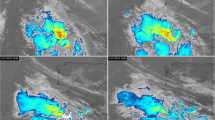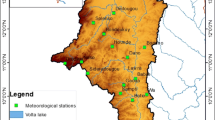Abstract
This study proposes two variants of the traditional conditional merging (CM) method that merges the next-generation radar (NEXRAD) ground gauge precipitation data. The first method, named CM considering simple optimal estimation (SOE), employs a novel algorithm of simultaneously considering rainfall spatial intermittency and inner variability to replace the conventional semivariogram algorithms of the CM method. The second variant, called CM-GR-SOE, employs additional Ground-Radar rainfall ratio (so called the G/R ratio) to the CM-SOE method. Model performance was evaluated using the hourly rainfall data collected between 2004 and 2007 in the regions of Houston and Dallas in Texas. The leave-one-out cross-validation was conducted, and the relative mean error (RME) and coefficient of determination (R2) were calculated for each of the methods. In areas where the rainfall intensity was low (<0.25 mm/h), NEXRAD Stage IV, and occasionally the CM method, showed lower absolute values of RME, and higher R2 values than other variants. As rainfall intensity increased (greater than 7.6 mm/h), the CM-GR-SOE method showed the best performance. Further analysis revealed that spatial correlations of rainfall field is the primary source of seasonal variability of the model performance. The analysis also revealed that the correlation between the model seasonal performance and the rainfall spatial correlation depends on the density of ground gauges. For this reason, the CM-GR-SOE method performed better at the Dallas area.
Similar content being viewed by others
References
Austin PM (1987) Relation between measured radar reflectivity and surface rainfall. Monthly Weather Review 115(5):1053–1070, DOI: https://doi.org/10.1175/1520-0493(1987)115<1053:RBMRRA>2.0.CO;2
Berndt C, Rabiei E, Haberlandt U (2014) Geostatistical merging of rain gauge and radar data for high temporal resolutions and various station density scenarios. Journal of Hydrology 508:88–101, DOI: https://doi.org/10.1016/j.jhydrol.2013.10.028
Chiles JP, Delfiner P (2012) Geostatistics: Modeling spatial uncertainty. John Wiley & Sons, Hoboken, NJ, USA
Cunha LK, Smith JA, Krajewski WF, Baeck ML, Seo BC (2015) NEXRAD NWS polarimetric precipitation product evaluation for IFloodS. Journal of Hydrometeorology 16(4):1676–1699, DOI: https://doi.org/10.1175/JHM-D-14-0148.1
Dao DA, Kim D, Kim S, Park, J (2020) Determination of flood-inducing rainfall and runoff for highly urbanized area based on high-resolution radar-gauge composite rainfall data and flooded area GIS data. Journal of Hydrology 584:124704, DOI: https://doi.org/10.1016/j.jhydrol.2020.124704
DeGaetano AT, Wilks DS (2009) Radar-guided interpolation of climatological precipitation data. International Journal of Climatology 29(2):185–196, DOI: https://doi.org/10.1002/joc.1714
Ehret U (2003) Rainfall and flood nowcasting in small catchments using weather radar. PhD Thesis, Institut für Wasserbau, Universität Stuttgart, Stuttgart, Germany
Fulton RA, Breidenbach JP, Seo DJ, Miller DA, O’Bannon T (1998) The WSR-88D rainfall algorithm. Weather and Forecasting 13(2): 377–395, DOI: https://doi.org/10.1175/1520-0434(1998)013<0377:TWRA>2.0.CO;2
Glickman TS, Zenk W (2000) Glossary of meteorology. American Meteorological Society, Boston, MA, USA
Goudenhoofdt E, Delobbe L (2009) Evaluation of radar-gauge merging methods for quantitative precipitation estimates. Hydrology and Earth System Sciences 13(2):195–203, DOI: https://doi.org/10.5194/hess-13-195-2009
Habib E, Larson BF, Graschel J (2009) Validation of NEXRAD multisensor precipitation estimates using an experimental dense rain gauge network in south Louisiana. Journal of Hydrology 373(3):463–478, DOI: https://doi.org/10.1016/j.jhydrol.2009.05.010
Hammer G, Steurer P (2000) Data documentation for data set 3240 (DSI 3240) hourly precipitation data. Tech. Doc. TD-3240, National Climatic Data Center, Asheville, NC, USA
Kang K, Merwade V (2014) The effect of spatially uniform and non-uniform precipitation bias correction methods on improving NEXRAD rainfall accuracy for distributed hydrologic modeling. Hydrology Research 45(1):23–42, DOI: https://doi.org/10.2166/nh.2013.194
Kim J, Lee J, Kim D, Kang B (2019) The role of rainfall spatial variability in estimating areal reduction factors. Journal of Hydrology 568(1):416–426, DOI: https://doi.org/10.1016/j.jhydrol.2018.11.014
Kitzmiller D, Miller D, Fulton R, Ding F (2013) Radar and multisensor precipitation estimation techniques in National Weather Service hydrologic operations. Journal of Hydrologic Engineering 18(2): 133–142, DOI: https://doi.org/10.1061/(ASCE)HE.1943-5584.0000523
Krajewski W (1987) Cokriging radar-rainfall and rain gauge data. Journal of Geophysical Research 92(D8):9571–9580, DOI: https://doi.org/10.1029/JD092iD08p09571
Lewis E, Quinn N, Blenkinsop S, Fowler HJ, Freer J, Tanguy M, Hitt O, Coxon G, Bates G, Woods R (2018) A rule based quality control method for hourly rainfall data and a 1 km resolution gridded hourly rainfall dataset for Great Britain: CEH-GEAR1hr. Journal of Hydrology 564:930–943, DOI: https://doi.org/10.1016/j.jhydrol.2018.07.034
Lyons SW (1990) Spatial and temporal variability of monthly precipitation in Texas. Monthly Weather Review 118(12):2634–2648, DOI: https://doi.org/10.1175/1520-0493(1990)118<2634:SATVOM>2.0.CO;2
McKee JL (2015) Evaluation of gauge-radar merging methods for quantitative precipitation estimation in hydrology: A case study in the Upper Thames River basin. MSc Thesis, University of Western Ontario, London, ON, Canada
Nadolski VL (1998) Automated surface observing system (ASOS) user’s guide. National Oceanic and Atmospheric Administration, Department of Defense, Federal Aviation Administration, United States Navy, Washington DC, USA
Nelson BR, Prat OP, Seo DJ, Habib E (2016) Assessment and implications of NCEP stage IV quantitative precipitation estimates for product intercomparisons. Weather and Forecasting 31(2):371–394, DOI: https://doi.org/10.1175/WAF-D-14-00112.1
Ochoa-Rodriguez, S, Wang LP, Gires A, Pina RD, Reinoso-Rondinel R, Bruni G, Ichiba A, Gaitan S, Cristiano E, van Assel J, Kroll S, Murlà-Tuyls D, Tisserand B, Schertzer D, Tchiguirinskaia I, Onof C, Willems P, ten Veldhuis MC (2015) Impact of spatial and temporal resolution of rainfall inputs on urban hydrodynamic modelling outputs: A multi-catchment investigation. Journal of Hydrology 531:389–407, DOI: https://doi.org/10.1016/j.jhydrol.2015.05.035
Oh M, Lee D, Kwon H, Kim D (2016) Development of flood inundation area GIS database for Samsung-1 drainage sector, Seoul, Korea. Journal of Korea Water Resources Association 49(12):981–993, DOI: https://doi.org/10.3741/JKWRA.2016.49.12.981
Pardo-Igúzquiza E, Grimes DI, Teo CK (2006) Assessing the uncertainty associated with intermittent rainfall fields. Water Resources Research 42(1), DOI: https://doi.org/10.1029/2004WR003740
Prat OP, Barros AP (2009) Exploring the transient of Z-R relationships: Implications for radar rainfall estimation. Journal of Applied Meteorology and Climatology 48(10):2127–2143, DOI: https://doi.org/10.1175/2009JAMC2165.1
Presti RL, Barca E, Passarella G (2010) A methodology for treating missing data applied to daily rainfall data in the Candelaro River Basin (Italy). Environmental Monitoring and Assessment 160(1–4), DOI: https://doi.org/10.1007/s10661-008-0653-3
Reed SM, Maidment DR (1999) Coordinate transformations for using NEXRAD data in GIS-based hydrologic modeling. Journal of Hydrologic Engineering 4(2):174–182, DOI: https://doi.org/10.1061/(ASCE)1084-0699(1999)4:2(174)
Schmandt J, North GR, Clarkson J (2011) The impact of global warming on texas. University of Texas Press, Austin, TX, USA
Seo DJ (1998a) Real-time estimation of rainfall fields using rain gauge data under fractional coverage conditions. Journal of Hydrology 208(1–2):25–36, DOI: https://doi.org/10.1016/S0022-1694(98)00140-1
Seo DJ (1998b) Real-time estimation of rainfall fields using radar rainfall and rain gauge data. Journal of Hydrology 208(1–2):37–52, DOI: https://doi.org/10.1016/S0022-1694(98)00141-3
Seo DJ, Breidenbach JP (2002) Real-time correction ofspatially nonuniform bias in radar rainfall data using rain gauge measurements. Journal of Hydrometeorology 3(2):93–111, DOI: https://doi.org/10.1175/1525-7541(2002)003<0093:RTCOSN>2.0.CO;2
Seo DJ, Breidenbach JP, Johnson ER (1999) Real-time estimation of mean field bias in radar rainfall data. Journal of Hydrology 223(3): 131–147, DOI: https://doi.org/10.1016/S0022-1694(99)00106-7
Silverman BW (1986) Density estimation for statistics and data analysis. CRC Press, Boca Raton, FL, USA, DOI: https://doi.org/10.1201/9781315140919
Sinclair S, Pegram G (2005) Combining radar and rain gauge rainfall estimates using conditional merging. Atmospheric Science Letters 6(1):19–22, DOI: https://doi.org/10.1002/asl.85
Smith JA, Krajewski WF (1991) Estimation of the mean field bias of radar rainfall estimates. Journal of Applied Meteorology 30(4):397–412, DOI: https://doi.org/10.1175/1520-0450(1991)030<0397:EOTMFB>2.0.CO;2
Smith B, Rodriguez S (2017) Spatial analysis of high-resolution radar rainfall and citizen-reported flash flood data in ultra-urban New York City. Water 9(10):736–753, DOI: https://doi.org/10.3390/w9100736
Smith JA, Seo DJ, Baeck ML, Hudlow MD (1996) An intercomparison study of NEXRAD precipitation estimates. Water Resources Research 32(7):2035–2045, DOI: https://doi.org/10.1029/96WR00270
TWBD (2012) TWBD climate website. Texas Water Development Board, Retrieved October 20, 2019, <http://www.twdb.texas.gov/publications/state_water_plan/2012/04.pdf>
Velasco-Forero CA, Sempere-Torres D, Cassiraga EF, Gómez-Hernández JJ (2009) A non-parametric automatic blending methodology to estimate rainfall fields from rain gauge and radar data. Advances in Water Resources 32(7):986–1002, DOI: https://doi.org/10.1016/j.advwatres.2008.10.004
Wang X, **e H, Sharif H, Zeitler J (2008) Validating NEXRAD MPE and Stage III precipitation products for uniform rainfall on the Upper Guadalupe River Basin of the Texas Hill Country. Journal of Hydrology 348(1):73–86, DOI: https://doi.org/10.1016/j.jhydrol.2007.09.057
**e H, Zhang X, Yu B, Sharif H (2011) Performance evaluation of interpolation methods for incorporating rain gauge measurements into NEXRAD precipitation data: A case study in the Upper Guadalupe River Basin. Hydrological Processes 25(24):3711–3720, DOI: https://doi.org/10.1002/hyp.8096
**e H, Zhou X, Hendrickx JM, Vivoni ER, Guan H, Tian YQ, Small EE (2006) Evaluation of NEXRAD Stage III precipitation data over a semiarid region. Journal of the American Water Resources Association 42(1):237–256, DOI: https://doi.org/10.1111/j.1752-1688.2006.tb03837.x
Acknowledgments
This research was supported by the Korea Environment Industry & Technology Institute (KEITI) through Water Management Research Program, funded by Korea Ministry of Environment (MOE) (Project No. 127557).
Author information
Authors and Affiliations
Corresponding author
Rights and permissions
About this article
Cite this article
Han, J., Olivera, F. & Kim, D. An Algorithm of Spatial Composition of Hourly Rainfall Fields for Improved High Rainfall Value Estimation. KSCE J Civ Eng 25, 356–368 (2021). https://doi.org/10.1007/s12205-020-0526-z
Received:
Accepted:
Published:
Issue Date:
DOI: https://doi.org/10.1007/s12205-020-0526-z




